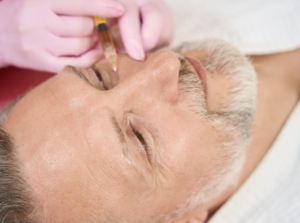Polynucleotide (PN) skin rejuvenation treatments have gained significant attention in aesthetic medicine. They involve a revolutionary, non-invasive procedure for enhancing skin texture and appearance. Based on utilising biological substances to stimulate tissue regeneration, PN treatments have emerged as a promising solution for individuals seeking to revitalise their skin without resorting to more invasive procedures.
What are Polynucleotides?
Polynucleotides are the building blocks of DNA molecules. They have been used since the 1950s for burn and wound healing and are known to possess bioactive properties that can aid in repairing and rejuvenating damaged skin.
They have been created synthetically or can be from animal origin. The most common products available for skin rejuvenation are extracted from salmon or trout sperm. The DNA is purified so that patients with fish allergies are still suitable for treatment.
Nucleofill and Plenhyage are created from Salmon DNA fragments, and Plinest is made from Trout DNA fragments.
How do Polynucleotides work?
When injected into the dermal layer of the skin, the PN DNA fragments act as signalling agents that stimulate fibroblasts and trigger the body’s natural regenerative processes, promoting cellular regeneration. This results in collagen and elastin synthesis and the production of essential structural proteins and hyaluronic acid, which improve hydration and moisture retention, restoring youthful skin characteristics.
As a result, patients may observe a reduction in the appearance of fine lines, wrinkles, and sagging skin. They also can create a healthier complexion and reduce the visibility of skin imperfections such as pigmentation irregularities and scars.
The gradual and cumulative effects of polynucleotide skin rejuvenation treatments make them a preferred option for individuals seeking gradual but noticeable improvements in their skin quality.
How long do the results of Polynucleotides last?
The results of PN treatments may generally last several months to a year. The average response lasts for six to nine months.
The duration of the effects of PN Treatments varies depending on the specific type of PN used, individual response to the treatment, and the initial condition of the skin. The longevity of their effects also depends on the body’s natural ageing process and environmental factors.
Which areas can Polynucleotides Treat?
PNs can revitalise the skin on all areas of the face and body.
- Face: To improve facial skin’s texture, tone, and elasticity. They can help reduce the appearance of fine lines, wrinkles, and other signs of ageing, resulting in a more youthful and radiant complexion.
- Neck and décolletage: The delicate skin on the neck and décolletage can also benefit from PN treatments, helping to tighten and firm the skin in these areas and reducing the appearance of lines and wrinkles.
- Hands: PN therapy can be used to rejuvenate the skin on the hands, minimising the visible signs of ageing, such as thinning skin, wrinkles, and age spots, thereby improving the overall texture and appearance of the hands.
- Body: PN treatments can also be applied to various areas of the body, such as the arms, abdomen, and thighs, to promote skin regeneration, improve elasticity, and reduce the appearance of cellulite and stretch marks.
- Scalp: In recent years, PN treatments have gained attention for their potential to promote hair growth and improve scalp health. When administered to the scalp, PN therapy can help strengthen hair follicles and stimulate hair growth, contributing to thicker and healthier-looking hair.
How many Treatments will I need?
Most people require three treatment sessions in total.
We recommend one session (2ml) every 14- 21 days.
Contraindications to Polynucleotide Treatment
- Pregnancy
- Breast Feeding
- Active skin infections
Patients with the following conditions can sometimes be treated with caution:
- Blood Thinning Medication
- Autoimmune conditions
What side effects can I expect after a PolyNucleotide Skin Rejuvenation Treatment?
During treatment, you will experience pin-prick bleeding and sometimes itchiness.
For several days, you can expect the following in the treatment area:
- redness
- slight swelling
- Bruising
Occasionally, the bruising and swelling can last longer.
After Care
- Avoid touching the treated area for at least 12 hours
- Avoid Makeup for 24hrs
- Avoid direct sun exposure
- SPF to protect the area and prevent further skin ageing.
- No facial treatments for two weeks
Who Performs Polynucleotide Treatments at Cheshire Lasers?
The following Doctors and Nurses perform Polynucleotide treatments at Cheshire Lasers:
- Dr Kyra Drinnan uses Plenhyage but can also use Nucleophill.
- Dr Hazlehurst uses mainly Plinest, Newest and Plenhyage but can also use Nucleophill
- Dr Teri Johnson uses Plinest, Plinest Hair and Plenhyage
In Conclusion
Polynucleotide skin rejuvenation treatments represent a breakthrough in the field of aesthetic medicine, offering a safe and effective solution for individuals looking to revitalise their skin’s youthful characteristics. By harnessing the regenerative potential of PN molecules, these treatments stimulate collagen synthesis, enhance skin hydration, and promote overall skin health, leading to a more radiant and youthful complexion. As the field of aesthetic medicine continues to evolve, polynucleotide skin rejuvenation is poised to remain a prominent player in the quest for achieving natural and long-lasting skin rejuvenation.

